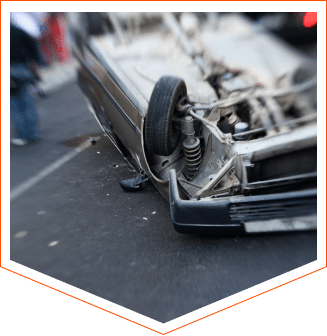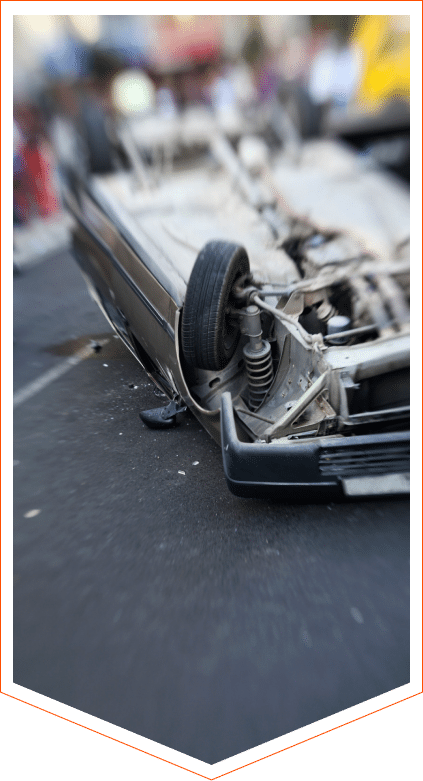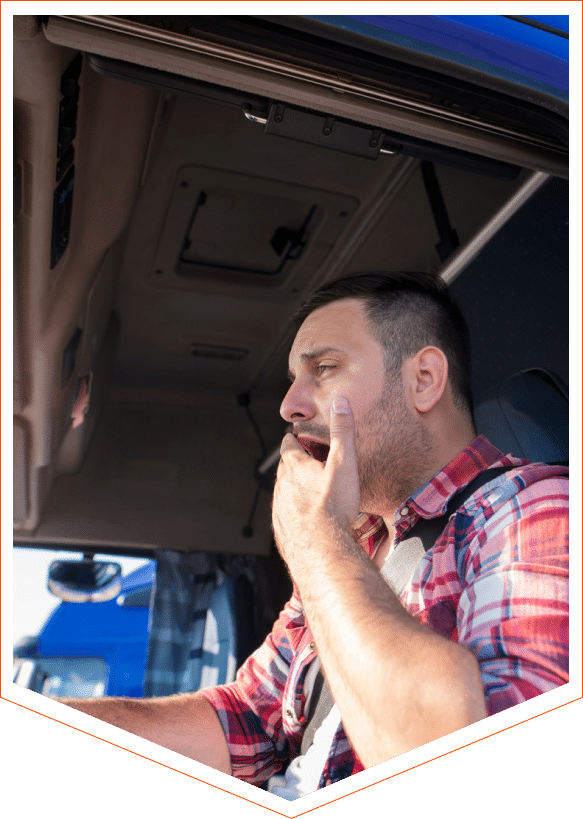Wake-Up Call on the Road: The Realities of Driving While Fatigued
Driving while fatigued can be a significant hazard, leading to severe accidents, injuries, and even fatalities. Thousands of accidents and hundreds of fatalities occur every year due to fatigued driving, emphasizing the importance of learning to recognize the signs of drowsiness while driving. Get drowsy driving help from our experienced accident lawyers at Chopra & Nocerino, LLP, and learn what to look for and when to consider pulling over for some rest.


Driving is an essential part of modern life that many take for granted. Many of us drive daily, going to and from work, picking our kids up from school, and traveling to various appointments.
However, driving a vehicle while fatigued—even for a short distance—is dangerous for you and everyone else on the road. Driving while fatigued can lead to severe accidents, injuries, and even fatalities. Recognizing the risks of drowsy driving helps you take appropriate measures to safeguard yourself, your passengers, and others on the road.

Fatigue is a Major Cause of Road Accidents

Driving while fatigued can have catastrophic results. Drowsy driving statistics show that thousands of accidents are caused by driving while fatigued annually.
In 2017, drowsy driving was a significant contributing factor to 91,000 crashes, resulting in 50,000 injuries and nearly 800 deaths. In 2021, 684 fatalities resulted from accidents involving drowsy driving—an 8.2 percent increase from the 632 lives lost in 2020.
Drowsiness is hazardous when you’re behind the wheel, as it can drastically impact multiple elements of safe driving, including:
- Your ability to make good decisions
- Your reaction time to brake or steer suddenly
- Your attention to the road
Microsleeps
A microsleep is a short span of sleep lasting up to 30 seconds. Sometimes, you may not even notice you’ve experienced a microsleep.
Microsleep often occurs due to sleep deprivation but may also stem from alcohol consumption, medical conditions affecting sleep, medications with sedative or hypnotic qualities, or night-shift work.
While it’s one thing to experience microsleep while winding down with your favorite show or book, such sleepy episodes on the road can prove fatal. Road conditions are ever-changing, and being unaware of your surroundings for just half a minute can lead to serious accidents.
Considering tens of thousands of accidents and hundreds of fatalities occur every year due to drowsy driving and microsleep, learning to recognize the signs of fatigue is essential to prevent accidents.
Factors That Impact Driving Fatigue
Driving fatigue dangers can stem from numerous factors, possibly a combination of factors, including the following:
Lack of Sleep
Prolonged wakefulness or inadequate sleep are significant contributing factors involved in driving fatigue. Sleep deprivation can wreak havoc on your body, leaving your brain exhausted and unable to complete tasks efficiently.
You may notice you have a tough time focusing or learning new things. Additionally, your reaction time might be slower due to the delay in signals traveling to and from your brain. These delays can decrease your coordination and increase your risk of an accident.
If you continually get too little sleep—less than seven hours per day—you gradually accrue “sleep debt,” making it more likely you’ll fall asleep unintentionally. This is associated with more reports of overwhelming drowsiness while behind the wheel.
Stress
Stress is often directly related to fatigue, acting as a root cause of high fatigue levels in many people. Prolonged stress, particularly high stress levels, can result in chronic fatigue and sleep disruptions, contributing to overall fatigue.
Excessive stress ties back into sleep deprivation, contributing to the overall fatigue issue and the dangers of drowsiness behind the wheel.
Irregular Sleep Patterns
Inconsistent sleep schedules and frequent waking periods during the night can contribute to overall fatigue. Various studies have discovered that irregular sleeping patterns can negatively affect the body’s metabolism, which regulates how we use energy and function overall.
The impact on energy use can contribute to overall feelings of fatigue and drowsiness, particularly while sedentary during driving.
Driving for Long Periods
Sitting behind the wheel for countless hours can contribute to fatigue, especially if you’re experiencing mental or physical exhaustion. Lengthy stretches of empty roads with little to no stimulus can cause your alertness to decrease, while longer sitting times can cause higher levels of general and physical fatigue.
Medications
Certain medications can contribute to feelings of drowsiness, heightening the importance of avoiding driving while taking these medications. Common medications that can cause sleepiness include:
- Antidepressants
- Antihistamines
- Antiemetics
- Antipsychotics
- Anticonvulsants
- High blood pressure medications
- Benzodiazepines
- Drugs to treat Parkinson’s disease
- Muscle relaxants
- Opioids
These medications often have drowsiness or fatigue listed as side effects on the packaging. Recognizing these side effects and reacting appropriately to avoid fatigue-related vehicle accidents is important.
Time of Day
The body’s natural biological clock can contribute to fatigue, as it causes highs and lows of drowsiness throughout the day. For many adults, drowsiness is at its highest between two and four in the morning and one and three in the afternoon.
Car accidents also rise during the shifts to and from daylight savings time due to the darker hours in the morning or evening.
Warning Signs of Driver Fatigue: Know When to Stop
Crucial to preventing drowsy driving is learning to recognize the signs. While pinpointing when you’ll fall asleep is tricky, fatigue often provides various warning signs before it pulls you into sleep, including:
- Muscle twitching
- Frequent yawning
- Back tension
- Shallow breathing
- Heavy, numb, or tingly sensation in your limbs
- Wandering or disconnected thoughts, including difficulty recalling the last miles you’ve driven
- Burning or heavy sensation in your eyes
- Difficulty focusing
- Frequent blinking
- Missing an exit, drifting in your lane, crossing roadway lines, or hitting the rumble strip
When you notice these signs, it’s time to pull over. Driving while fatigued isn’t safe and raises the risk of an accident, so it’s essential to recognize the signs and take the proper action by pulling over to rest and recuperate.
Sleep Conditions and Driving
Sleep conditions, including insomnia, sleep apnea, and narcolepsy, can contribute to the hazards of driving while fatigued. An estimated 50 to 70 million Americans across the United States have a sleep disorder, while many more have untreated and undiagnosed sleep issues.
There are over 90 types of sleep disorders, but the most common include:
Insomnia is the inability to fall and stay asleep. It’s the most common sleep disorder. While you can drive if you have mild insomnia, most physicians recommend patients with severe insomnia avoid driving.
Sleep apnea is a breathing disorder that causes breathing to cease for ten or more seconds during sleep, disrupting your sleep patterns. If you have sleep apnea, you may still drive with proper treatment.
Parasomnia involves unusual actions while falling asleep, sleeping, or waking from sleep, including talking, walking, or eating. Medications for parasomnia can make you feel drowsy, so it’s essential to be cautious about when and if you get behind the wheel.
Hypersomnia involves difficulty remaining awake during the day. This condition encompasses narcolepsy, known for causing extreme daytime sleepiness. The severity of these conditions can vary drastically from person to person, so there isn’t a general rule for driving with this condition.
Restless leg syndrome involves a tingling or prickly sensation in the legs that may trigger a powerful urge to move them. Driving with this syndrome is possible if you take the proper measures to manage discomfort.
Circadian rhythm disorders are characterized by complications with the sleep-wake cycle, making it difficult to sleep and wake at the correct times. This condition is manageable with treatment, but it’s essential to recognize the signs of drowsiness and adjust accordingly.
How To Manage the Risks of Drowsy Driving
Practicing various management techniques to minimize the risks of drowsy driving can help avoid accidents involving it. These practices include:
- Good sleep habits
Get at least seven hours of sleep per night regularly. Try to maintain regular bedtimes and waking times.
- Avoid alcohol
Drinking before driving is dangerous enough, but when combined with fatigue, it can exacerbate drowsiness and impairment.
- Monitor medications
Check for fatigue and drowsiness as a side effect of any medications you take. If your medications list either as a side effect, avoid driving and use public transportation whenever possible.
- Avoid peak sleepiness hours
If possible, avoid driving during peak sleepiness hours, including the early morning and the early to late afternoon.
- Pull over
If you feel drowsy or think you’ve experienced a microsleep, it’s time to pull over. It’s best to take a break and get a nap, even a short nap, to replenish your energy stores.
You may be tempted to grab a few cups of coffee on the way to minimize drowsiness. While caffeine blocks adenosine from acting on brain cells, which prevents you from feeling drowsy, it’s often a short-term fix. Some individuals may experience a “crash” after the effects of the caffeine wear off, leaving them feeling more tired than before.
Sleep Tips for Truckers and People Who Are Constantly on the Road
Truckers and other individuals who are constantly behind the wheel must take extra precautions to promote their safety and that of others on the road. Various sleep tips for staying awake while driving can help you get better sleep and minimize fatigue, including:
Minimize disturbances
Block out all lights, minimize noise, and park in a safe place. Additionally, reduce disruptions to your sleep by asking your family, friends, and dispatchers not to disturb you while you sleep.
Get comfortable
Keep your cab or bedroom temperature at your preferred level, and choose a comfortable mattress and pillow to promote good quality sleep.
Avoid heavy meals and liquids
If you’re going to eat a heavy or spicy meal, eat it at least three hours before bed. Additionally, try to consume less liquids before sleep to minimize trips to the bathroom.
Minimize caffeine consumption
Avoid consuming caffeine before sleep, as it can impact your ability to get good quality sleep.
While you play an essential role in minimizing fatigue behind the wheel, so does your employer. For example, companies can implement various policies and practices to promote the well-being of drivers, including mandated breaks or specific driving limits.
The Federal Motor Carrier Safety Administration outlines specific guidelines for truck drivers to promote safety, including the 14-hour “driving window,” the 11-hour driving limit, and hour limits based on the number of days on duty.
In addition to these regulations and policies, emerging tech may also contribute to fatigue control while driving. Fatigue monitoring systems, smart wearables, and various apps that track driving behavior have the potential to aid in reducing fatigue-related accidents and fatalities.
Laws and Tired Driving
Few states outline explicit laws against drowsy driving. Arkansas and New Jersey are the only states with specific drowsy driving laws. While widespread legislation on drowsy driving could make the roads safer for everyone, it has yet to make its way to the scene.
If you’ve been involved in a drowsy driving accident, talk to a skilled lawyer with an in-depth understanding of laws that may apply to your case. When choosing a lawyer, look for one with a track record of success in those cases. Additionally, be sure to contact your lawyer as soon as possible after the accident, as the statute of limitations in your state may end sooner than you expect.

Public Awareness and Education of Driving and Fatigue
Awareness is a crucial part of preventing fatigue-related vehicle accidents. As more drivers learn about how dangerous drowsy driving is, we can collectively take action to reduce the number of accidents.
Numerous organizations have taken steps to increase awareness on this topic, including the following:

Talk about drowsy driving with your friends, family, and coworkers. Share valuable information and resources detailed here to help increase awareness and promote the safety of your loved ones on the road.
By understanding the factors that cause fatigue and recognizing the warning signs, we can take necessary precautions to avoid driving while feeling drowsy and save lives. So, let’s spread awareness about this critical issue and work towards making our roads safer for everyone.










